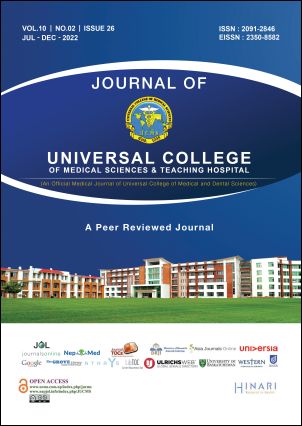The Relationship Between the Weight of the Placenta and Birth Weight of the Neonate
DOI:
https://doi.org/10.3126/jucms.v10i02.51281Keywords:
Fetal weight, placental weight, placental-birth weight ratioAbstract
INTRODUCTION Weight of placenta has long been associated with fetal growth and perinatal well-being. Low placental weight (standardized for sex and gestational age) is more common among stillbirths whereas high placental weight is associated with neonatal death, serious neonatal morbidity, low 5-min Apgar score, and respiratory morbidity. Low placental weight is believed to reflect an inadequate placental surface area for nutrient and gas exchange, leading to fetal compromise. However, it has also been proposed that the increased risk associated with high placental weight is the result of villous oedema, which may compress blood vessels and reduce transfer of gas and nutrients to the fetus.
MATERIAL AND METHODS A descriptive cross-sectional study of the total, 798 subjects met the inclusive criteria. After consent, age, sex, prepregnancy weight, weight of mother at the time of delivery, neonatal weight and trimmed placental weight were recorded.
RESULTS The mean birth weight was 2818±447.19 gm while the placental weight was 489.29±59 gm with mean placental-fetal weight ratio of 17.63. The mean birthweight of male was 2823.97±451.12 gm whereas female was 2811.69±442.93 gm. Similarly, mean placental weight of male was 490.37±57.7 gm and female was 487.98±60.58 gm. As gestational age increases placental and birth weight also increases whereas placental-birth weight ratio decreases.
CONCLUSION There is a positive relation between placental weight and weight of the neonate at the time of birth. However, the ratio of the placental and neonatal birth weights at term decreases with advancing gestational age. Thus, prolongation of pregnancy at term may adversely affect the fetus.
Downloads
Downloads
Published
How to Cite
Issue
Section
License
Copyright (c) 2022 Journal of Universal College of Medical Sciences

This work is licensed under a Creative Commons Attribution-NonCommercial 4.0 International License.
Authors have to give the following undertakings along with their article:
- I/we declare that this article is original and has not been submitted to another journal for publication.
- I/we declare that I/we surrender all the rights to the editor of the journal and if published will be the property of the journal and we will not publish it anywhere else, in full or part, without the permission of the Chief Editor.
- Institutional ethical and research committee clearance certificate from the institution where work/research was done, is required to be submitted.
- Articles in the Journal are Open Access articles published under the Creative Commons CC BY-NC License (https://creativecommons.org/licenses/by-nc/4.0/)
- This license permits use, distribution and reproduction in any medium, provided the original work is properly cited, and it is not used for commercial purposes.




